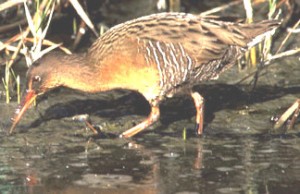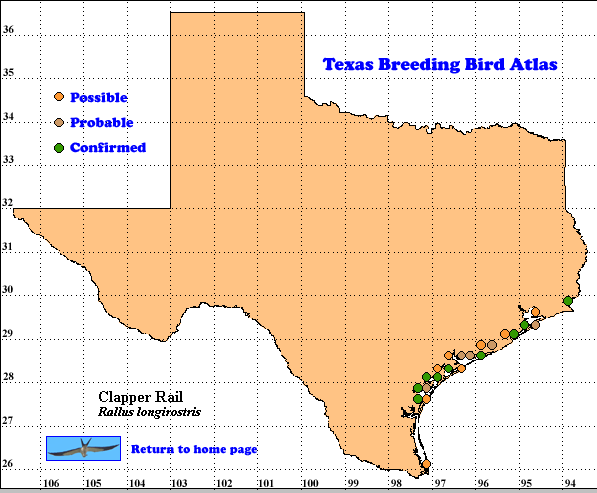The sound of a series of kek notes from a salt marsh is often the first and sometimes the only clue to the presence of a Clapper Rail. These large rails are highly opportunistic as they forage on small crabs (the favorite food), slugs, minnows and aquatic insects, while stalking slowly and stealthily through dense vegetation. Other prey include grasshoppers, small vertebrates, seeds, amphipods other bird’s eggs and occasionally immobilized small birds. In addition to walking these rails are occasionally seen swimming across channels or flying low over marshes (Eddleman and Conway 1998).
Many populations of Clapper Rails are separated by natural or human-caused gaps in appropriate habitats. As a result the species has more than two dozen recognized subspecies. Clapper and King (R. elegans) rails are closely related and hybridization has been observed where their ranges abut along the Atlantic and Gulf coasts (Meanley, 1992, Am. Ornithol. Union 1998, Eddleman and Conway 1998).
DISTRIBUTION. During the 1987-1992 field work seasons of the TBBA project, researchers found 11 confirmed, 10 probable and 10 possible breeding sites with 17 (55%) of these in latilong 28096 in the Coastal Prairies region (see the region map in Lockwood and Freeman [2004]). Only 4 breeding sites were found in latilongs south of 28096. The map derived from North American Breeding Bird Survey (BBS) data (Sauer et al. 2007) is similar to the TBBA map.
The species also breeds along the Gulf Coast from Texas to Florida and up the Atlantic Coast to Massachusetts. Another population breeds along the lower Colorado River. Breeding along the Pacific Coat is limited by the availability of appropriate habitat and stops at San Francisco Bay. Clapper Rails have not been detected in Washington State. Clapper Rails also reside on many parts of the coastlines of Mexico, Central America, Caribbean islands and South America to Peru and southern Brazil. Populations from New England to the mid-Atlantic states are migratory, moving south in winter (Howell and Webb 1995, Am. Ornithol. Union 1998, Eddleman and Conway 1998, Sauer et al. 2007, Wahl et al. 2005).
SEASONAL OCCURRENCE. Clapper Rails are resident along the Texas coast where they breed from late February to September, based on egg collection dates from April 13 to late August and chicks just out of the nest observed as early as March 29 (Oberholser 1974, Lockwood and Freeman 2004).
BREEDING HABITAT. In Texas Clapper Rails are residents of coastal salt marshes thickly grown to rushes, reeds or Spartina grass (Oberholser 1974). In Arizona where these rails breed along the Colorado River, more than 95% of breeding evidence for the Yuma Clapper Rail (R. l. yumanensis) came from freshwater lakes, reservoirs and marshes edged with cattails and other emergent vegetation. This subspecies is the only population not breeding in saltwater (Eddleman and Conway 1998, Wise-Gervais 2005).
Clapper Rail nests are bulky platforms, 8-15 cm (3-6 in) high, elevated above the high tides, built of dry materials such as cordgrass, pickleweec or salt grass. The nests are placed within emergent vegetation, which is arched over the nest, or in the crotches of shrubs. The inside diameter is about 14 cm (6 in), cup depth 5 cm (2 in). During periods of high water more material is added to the nest platform to raise the eggs higher above water (Eddleman and Conway 1998).
Females on the Gulf Coast of the United States lay an average of 9.5 (range 7–14) buff to white eggs with brown spots. One egg is laid per day. Both sexes incubate for about 20 (range 18-22) days (see photo of incubating bird in Harrison [1979]). After hatching the semi-precocial young, covered with black down are brooded in the nest by their parents for several days. Young can swim, dive and forage on small prey soon after hatching. They are brooded by their parents on platforms built for this purpose. Most growth occurs in the first 3 weeks before body feathers erupt. The young are independent of their parents by 6 weeks after hatching, although their flight feathers are less than half grown (Eddleman and Conway 1998,
STATUS. The map in Oberholser (1974) shows a similar coastal distribution to the distribution found by TBBA atlasers. Lockwood and Freeman (2004) describe the species as common in brackish or salt marshes along the coast. BBS data (Sauer et al. 2007) for Texas and the United States are not based on sufficiently large samples to provide meaningful biological trends. The presence of 3 western subspecies of this rail on the Endangered Species list (Harrison 1979) and its status as a hunted species in eastern states are not encouraging omens for Clapper Rail populations anywhere.
Text by Robert C. Tweit (2008)
Literature cited.
American Ornithologists’ Union. 1998. Checklist of North American birds, 7th ed. Am, Ornithol. Union, Washington, DC.
Eddleman, W. R. and C. J. Conway. 1998. Clapper Rail (Rallus longirostris), The Birds of North America Online (A. Poole, Ed.). Ithaca: Cornell Lab of Ornithology; Retrieved from: http://bna.birds.cornell.edu/bna/species/340
Harrison, H. H. 1979. A field guide to western birds’ nests. Houghton Mifflin, Boston, MA.
Howell, S. N. G. and S. Webb. 1995. A guide to the birds of Mexico and northern Central America. Oxford University Press, New York.
Lockwood, M. W. and B. Freeman. 2004. The TOS handbook of Texas birds. Texas A&M University Press, College Station.
Meanley, B.1992. King Rail (Rallus elegans). In The birds of North America, No. 3 (A. Poole and F. Gill, eds.). The Birds of North America, Inc., Philadelphia, PA.
Oberholser, H. C. 1974. The bird life of Texas. University of Texas Press, Austin.
Sauer, J. R., J. E. Hines, and J. Fallon. 2007. The North American breeding bird survey, results and analysis 1966-2006. Version 7.23.2007. USGS Patuxent Wildlife Research Center, Laurel MD < http://www.mbr-pwrc.usgs.gov/bbs>
Tweit, R. C. 2008. King Rail (Rallus elegans) The Texas Breeding Bird Atlas Online (K. A. Arnold and K. L. P. Benson, eds.). Texas A&M University, College Station, TX. Retrieved from: http://txtbba.tamu.edu
Wahl, T. R., B. Tweit and S. G. Mlodinow, eds. 2005. Birds of Washington: Status and Distribution. Oregon State University Press, Corvallis.
Wise-Gervais, C. 2005. Clapper Rail (Rallus longirostris). In Arizona breeding bird atlas. pp. 162-163 (T. E. Corman and C. Wise-Gervais, eds.), University of New Mexico Press, Albuquerque.

